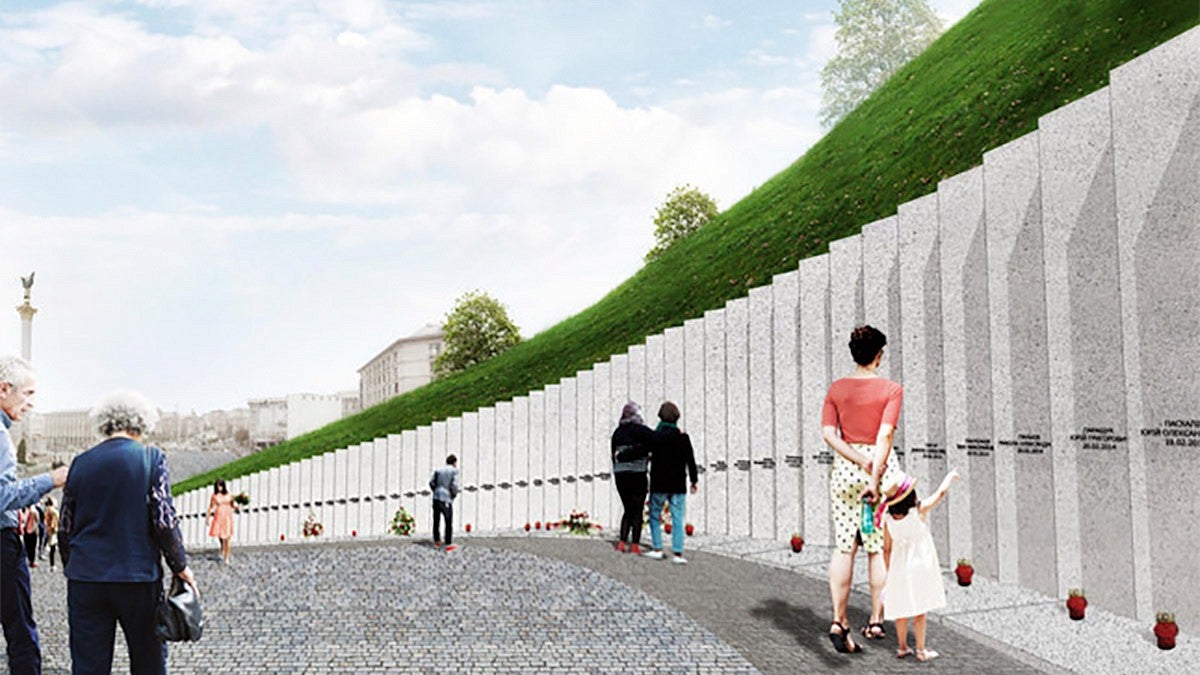
Sunny illustrations show a curved path lined with flowering linden trees and stone tablets winding through the heart of Kiev, ending at the Maidan Nezalezhnosti, the city’s central square.
Five years ago, it was one of the sites of the months-long Euromaidan protests in Ukraine, where thousands of citizens flooded the streets to demonstrate against government corruption and human rights violations. Riot police descended into the crowds and, in the clash, more than 100 people were killed.
The path reflects the Ukrainian people’s difficult fight for freedom, the lindens represent hope, and the tablets feature the names of the victims, explained Iryna Volynets.
Volynets is a PhD in landscape architecture candidate from Ukraine. The country’s Ministry of Culture chose Volynets’ company MIstudio (with partner Mariya Protsyk) as the winner of a design competition to build the National Memorial to the Heavenly Hundred Heroes. Volynets, who also runs the Volynets Architectural Bureau, is currently in Ukraine working on final proofs for the memorial.

“Iryna’s design work addresses cultural identity by combining landscape and built form with contemporary elements to create spaces that evoke memories of the past,” said Nancy Cheng, head of the Department of Architecture. “Her architectural practice combines conceptual design thinking with compelling visual storytelling and business savvy. We are hoping that she can help us strengthen the bridge between the landscape architecture and architecture departments.”
After receiving a master of architecture from the Lviv Polytechnic National University in 2013, Volynets came to the College of Design in 2015 as a visiting Fulbright scholar. While at the UO, Volynets produced as part of her research the book Landform [in] Architecture, an exploration of natural landforms. She also helped teach two studios with architecture faculty member and head of the School of Architecture & Environment, Erin Moore: one about the morphology of the space of fossil fuel transportation and another called Ice, Time, and Tourism which focused on the Mendenhall Glacier Visitors Center.
“I am impressed with Volynets’ work with MIstudio, in particular the way their work brings a high level of urban design thinking to spaces of layered political and cultural contexts—as in the proposal for the memorial park for the 2014 Maidan Revolution in Kiev and the Holocaust Memorial Visitor Center,” Moore said. “It is also notable that these are both commissions awarded through international design competitions; an important vehicle for communities to spark design dialogue and also for emerging design talent to gain visibility.”
This spring, she returned as a visiting faculty member to teach a studio in the Department of Landscape Architecture and a graduate studio and seminar in the Department of Architecture. In September, she will return again to the College of Design to finish her PhD, which she started in Ukraine.
“I realized I wanted something more,” Volynets said of continuing her education. “I’m really interested in the process of creating landform architecture—a kind of architecture that connects buildings and landscape, allowing you to blend buildings into the landscape or bring the landscape in.”
Volynets applied this concept to the information center at the Babi Yar Holocaust Memorial Center in Kiev, another project for which MIstudio won a design competition. While in Ukraine, Volynets will also work on this project, which features a pavilion with a white cube structure encasing a black observation cube engraved with 33,771 numbers, representing the victims killed by Nazis in a two-day massacre.

“The structure highlights the topography of the place where people were killed,” Volynets explained. The white cube, she said, symbolizes the unity of the people before the Holocaust and the black square represents the scar of this tragedy.
While these high-profile architecture and landscape commissions have elevated the work of Volynets, as an architect, she said she still faces discrimination because of her gender and age (she’s under 30).
“In the last year I learned how to protect my ideas, how to fight for my ideas, and how to protect myself,” Volynets said. “That leads to the final point, which is to believe in yourself.”
For her PhD, Volynets will continue her practice-based research into landform architecture. Upon completion of her PhD, she would like to apply that research at her firm in the Ukraine. Volynets’ advisers will be Head of the Department of Landscape Architecture and Associate Professor Roxi Thoren and Assistant Professor of Landscape Architecture Mark R. Eischeid.
